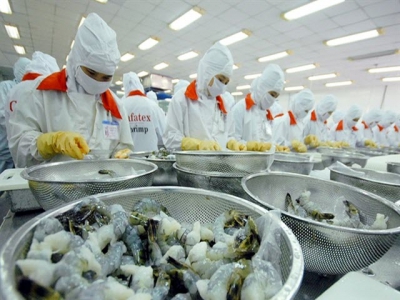VN seafood companies face barriers in home market

Seafood companies are concerned as the year-end and Tet sale season nears, the doors to supermarkets are closed to their products.
Seafood products are facing barriers in home market
They are worried about strict MRPL (Minimum Required Performance Limit) regulations for chemicals and antibiotics residue set by management agencies, described as ‘stricter than EU requirements’.
In a document to agencies, the Vietnam Association of Seafood Exporters and Producers (VASEP) asked why products that satisfy EU standards cannot meet requirements in Vietnam.
VASEP once lodged a complaint about the issue to ministries and had working sessions with the Ministries of Health (MOH) and Agriculture & Rural Development (MARD) in late August.
MARD sent documents to MOH proposing to set MPRLs for prohibited chemicals and antibiotics with reference to the MPRLs set by the EU.
However, to date, the association still has not received a reply, while September, the most important time for seafood companies to take orders for Tet, has ended.
Seafood companies are now facing many problems, from unreasonable policies and increased input costs to high discount rates required by retail chains.
One year ago, seafood companies were distressed by a legal document – the Decree 09 on fortifying iodine in processed food.
Food processing experts pointed out that food structure will change when heated, because iodine interacts with other ingredients.
VASEP also explained that adding iodine will cause discoloration, odor and color changes, while the antioxidant capacity will no longer exist.
In July 2018, or three years after the promulgation of the decree, EuroCham said that the requirement on iodine would cause challenges to the food processing industry.
Meanwhile, the Ministry of Health still has not amended the decree as instructed by the Prime Minister.
As a result, seafood companies still have to struggle as they have to fortify micronutrients in food. Some seafood processors complain that their domestic market share has become narrower.
Analysts commented that seafood companies are now facing many problems, from unreasonable policies and increased input costs to high discount rates required by retail chains.
Le Thi Thanh Lam, deputy CEO of Sai Gon Food, said on Thoi Bao Kinh Doanh that there are two distribution channels in the frozen seafood market – traditional and modern.
About 68 percent of businesses target modern distribution channels, while 32 percent, mostly small workshops, target the traditional channel.
Vietnam exported $6.395 billion worth of seafood products in the first nine months of 2018, according to MARD, an increase of 7.2 percent over the same period last year.
Experts have warned that with protectionism pursued by the Trump administration, Vietnam’s exports, including seafood, to the US will face big challenges.
Có thể bạn quan tâm
 Sóc Trăng farmers earn more after agricultural restructuring
Sóc Trăng farmers earn more after agricultural restructuring The restructuring of agricultural production in the Mekong Delta province of Sóc Trăng has helped farmers adapt to climate change, produce hi-tech products
 Aquatic product exports likely to rake in $9 billion this year
Aquatic product exports likely to rake in $9 billion this year Vietnam’s aquatic products are forecast to bring home 9 billion USD from exports in 2018, up 7 percent from the previous year
 Shrimp by-products called ‘gold mine’ for processing industry
Shrimp by-products called ‘gold mine’ for processing industry An international conference was held in the Mekong Delta city of Can Tho on October 3 to discuss ways to improve the value of shrimp by-products in Vietnam.